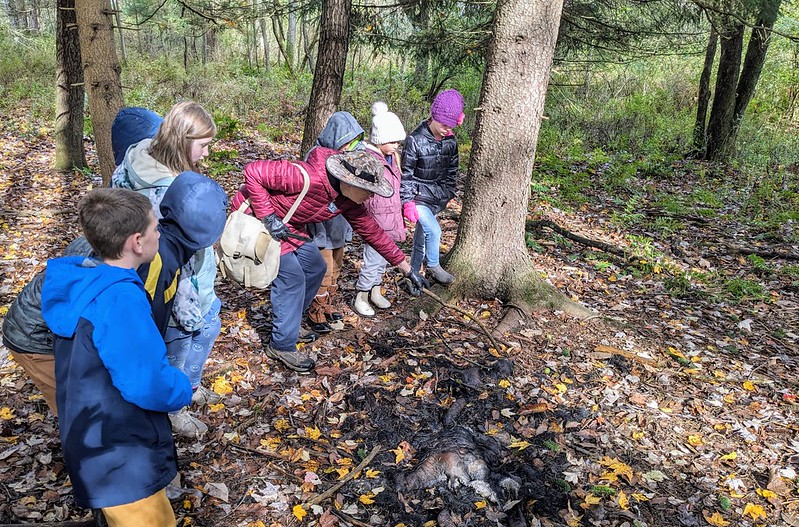By Emma Roth, Nature Educator and Animal Care Specialist
I find myself getting excited over strange things sometimes. This happened recently, as I was driving to work on Route 62, and suddenly came across a Black Bear. Coming across a Black Bear is always an exciting event. The difference this time was the bear was dead.
Of course, it is always disappointing to see a wild animal dead on the side of the road, especially one as majestic as the Black Bear. However, as nature educators at ACNC, we are able to use unfortunate circumstances like this as a teaching opportunity, and this was an opportunity I didn’t want to pass up.
Now, I like to think I am good at working with the gross side of nature. I have bagged up and transported quite a few critters I have found on the side of the road. A Black Bear, however, was a bit beyond my comfort zone, and the capacity of my car’s trunk. So, with a sense of urgency I continued toward ACNC, immediately calling my coworker Katie when I arrived to tell her the news and ask, “Do we want Black Bear?” The answer, of course, was yes.
I grabbed gloves, a willing volunteer and his truck (Thanks Terry!), and copies of ACNC’s New York state salvage permits, and off we went to collect the bear.
After getting to the location and examining the bear, we were happy to see it must not have been there long. There was very little insect activity around it and the body was still easy to manipulate. The heavy bear proved to be too much for Terry and myself to lift, but just in the nick of time, the road clean-up crew arrived. After looking over our permits, they were happy to help us load the bear into the truck and send us on our way.
But why do we want this bear? For classroom programs, we often use real animal props to demonstrate animal adaptations. We even teach a bear program in which we bring skulls, fur, and paws to schools. However, this bear was not suitable for classroom visits, and we had another plan. We decided it was a great opportunity to let it decompose, and let our students and campers get up close and personal with this fascinating process.
After getting the bear safely to ACNC, we put it in the woods. We knew we had students coming for school field trips in the coming week and this was an amazing opportunity to show them this part of the natural cycle of life first-hand. We found a spot easily accessible by groups, but far enough off the trail it wouldn’t be stumbled upon by unsuspecting visitors, and let nature get to work.
Within a few days the bear completely changed. It went from a relatively normal looking Black Bear to a barely recognizable mass of flies, maggots, beetles, and other decomposers that were having the time of their lives. A few days after that, the bear was no longer bear-shaped, more closely resembling a bear-sized puddle of fur and bones.
The students who saw this bear in these stages were fascinated. Before viewing the bear, I took a group to the garden compost to introduce the topic of decomposition and explained what we were going to find in the woods. We talked about how the bear would be benefiting all the animals that would be eating it, and the plants that would be able to grow from the nutrients it would add to the soil. When looking at the bear, the students pointed out all the maggots, beetles, flies, and worms. We noticed what parts of the bear were decomposing the fastest and guessed what parts would take the longest to decompose.
While there were some initial “gross’ reactions from the kids when we first approached the bear, and the smell was less than pleasant, the fascination won out and by the end, it was hard to get the kids to come away and allow another group to examine it.
It is always a joy to expose students to new things or new experiences. It’s even more fulfilling when an experience they had pre-conceived to be gross or disgusting ends up being one of their favorite parts of their ACNC visit. Yes, decomposition can be gross. It is smelly, the bugs are creepy, and it’s sad to see a dead animal. But it also provides the perfect opportunity to talk about the cycle of life, how dead and decaying things help the environment, and gives students a memorable and positive experience with this process.
Audubon Community Nature Center builds and nurtures connections between people and nature. ACNC is located just east of Route 62 between Warren and Jamestown. The trails and outdoor facilities are open from dawn to dusk. The Nature Center is open from 10 a.m. until 4:30 p.m. daily except Sunday when it opens at 1 p.m. More information can be found online at auduboncnc.org or by calling (716) 569-2345.


Recent Comments